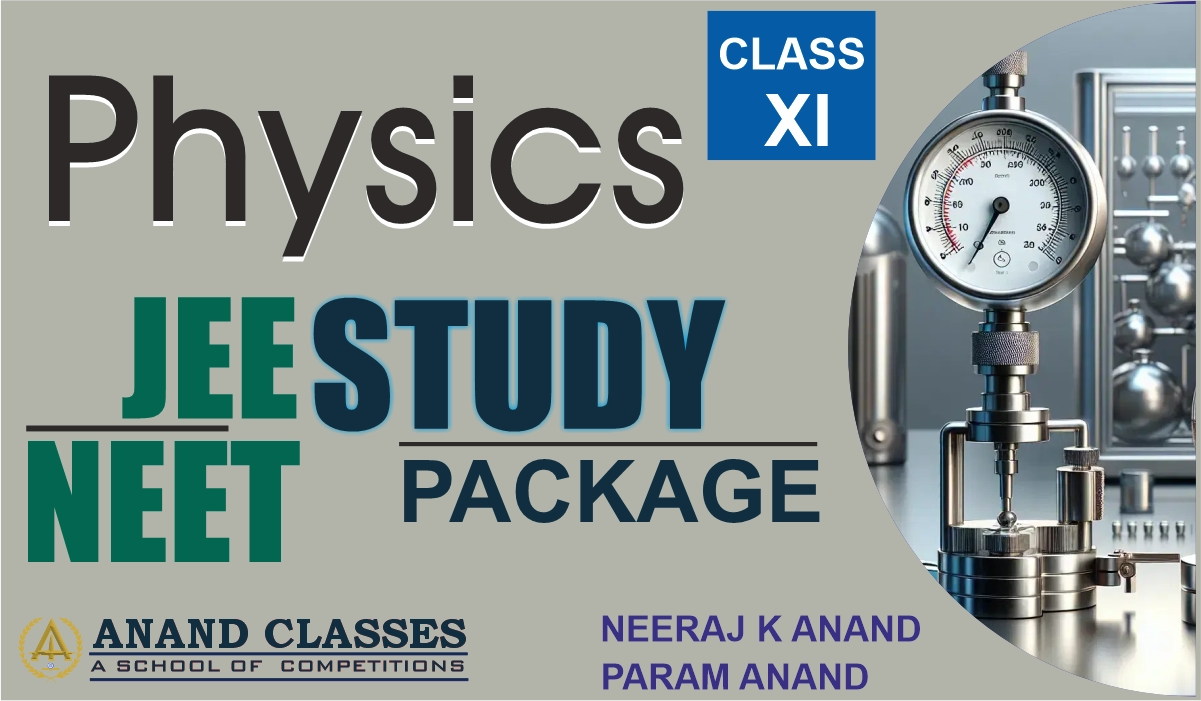ANAND CLASSES study material and notes to learn Speed-Time Graphs in detail with mathematical derivations, proofs, exam-based questions, MCQs, and worksheets. Ideal for JEE, NEET, and CBSE Class 11 students.
Types of Speed-Time Graphs with Detailed Explanation and Proofs
1. Speed-Time Graph When Speed Remains Constant
- When the speed of a body remains constant, there is no acceleration.
- The speed-time graph is a straight horizontal line parallel to the time axis.
- The area under the graph gives the distance traveled.
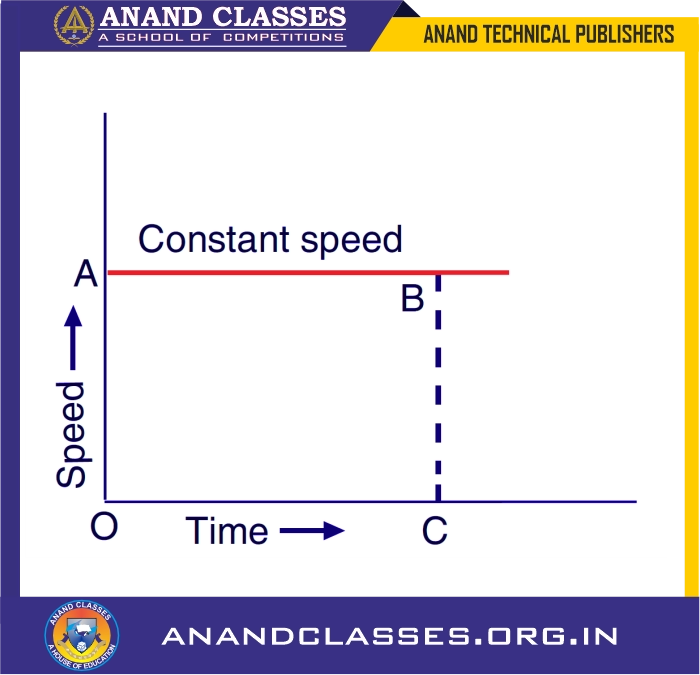
Mathematical Derivation:
Since the speed remains constant, we use the formula: $$\text{Speed} = \frac{\text{Distance}}{\text{Time}}$$
Rearranging for distance: $$\text{Distance} = \text{Speed} \times \text{Time}$$
From the graph, this corresponds to the area of the rectangle formed under the speed-time curve:
$$\text{Distance} = \text{OA} \times \text{OC}$$
Thus, the total distance traveled by the body is equal to the area under the speed-time graph.
📌 Related Posts:
Vector And Scalar Quantities – Definition and Examples
|
Types of Vectors-Physics Class 11 CBSE Notes
|
Statics and Dynamics in Physics-Difference between Statics and Dynamics, MCQs, Test Paper, Questions-Answers
|
Physical Quantity Constants for Physics | Question-Answer, FAQS, Worksheet, MCQS, Test Paper
|
Laws of Motion-CBSE Class 11 Physics Notes Study Material
2. Speed-Time Graph When Speed Changes at a Uniform Rate (Uniform Acceleration)
- The speed-time graph is a straight line with a positive slope.
- Acceleration is given by the slope of the graph.
- The distance traveled is given by the area under the graph, which forms a triangle.
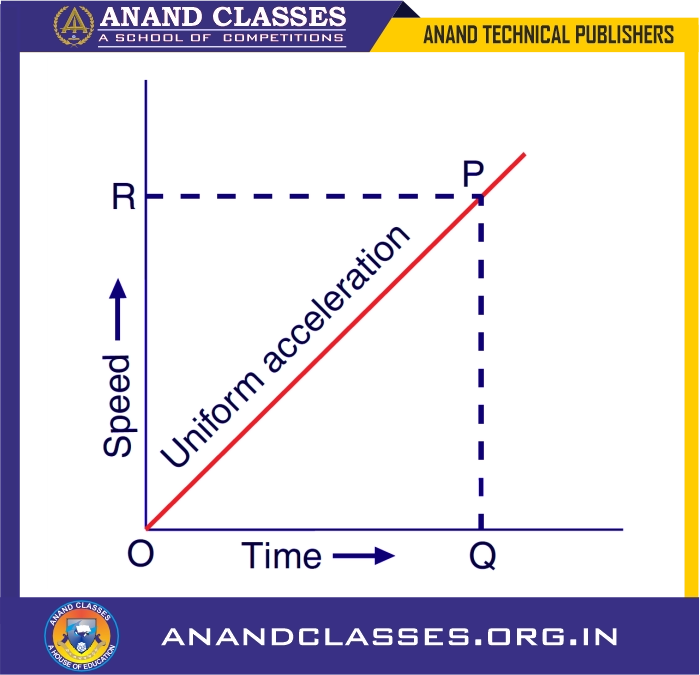
Mathematical Derivation:
We define acceleration as: $$ a = \frac{v – u}{t}$$
where:
- $u$ = initial speed
- $v$ = final speed
- $t$ = time
The change in speed is represented by PQ whereas time taken is equal to OQ. So,
$$ a = \frac{PQ}{OQ}$$
But $ \frac{PQ}{OQ}$ is the slope (or gradient) of the speed-time graph OP, therefore, we conclude that in a speed-time graph, the acceleration is given by the slope of the graph. In other words, the slope of a speed-time graph of a moving body gives its acceleration.
From the speed-time graph, the distance traveled is given by the area under the curve OPQ.
The distance travelled by the body in the time corresponding to point Q will be equal to the area of the triangle OPQ, which is equal to half the area of the rectangle ORPQ.
Thus, Distance travelled = Area of triangle OPQ
$$\text{Distance} = \frac{1}{2}\times\text{OR} \times \text{OQ}$$
Thus, the total distance traveled by the body is equal to the area under the speed-time graph.
3. Speed-Time Graph When the Initial Speed of a body is not zero
In this case speed-time graph when the initial speed of a body is not zero and to determine the distance traveled using the area under the graph.
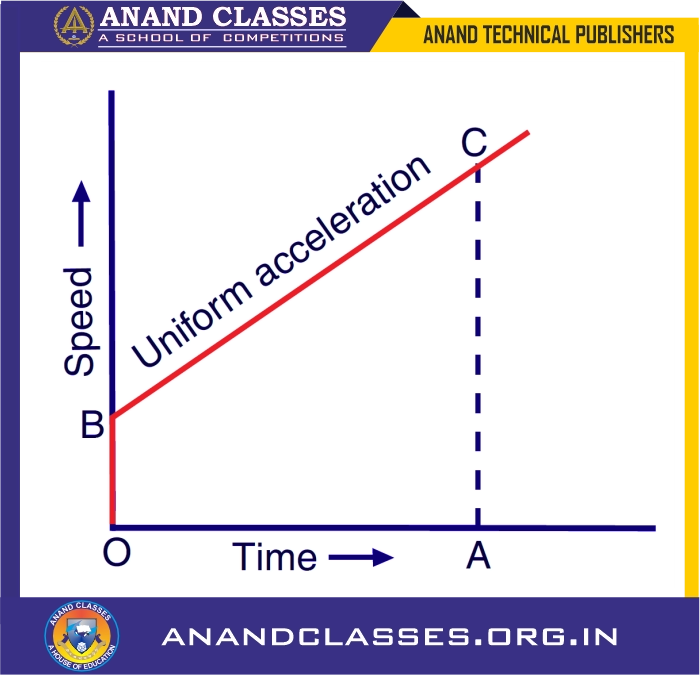
- Graph Explanation:
- The speed-time graph represents an object that starts with an initial speed OB and accelerates uniformly to speed AC over time OA.
- The curve is a straight line (uniform acceleration).
- Acceleration Calculation:
- The acceleration aa can be determined using: $$a = \frac{\text{final speed} – \text{initial speed}}{\text{time}} $$ $$a = \frac{AC – OB}{OA}$$
- Distance Calculation Using Area Under Graph:
- The area under the speed-time graph represents the distance traveled.
- The shape OBCA is a trapezium.
- The area of a trapezium is given by: $$\text{Area} = \frac{\text{sum of parallel sides} \times \text{height}}{2}$$
- In this case:
- Parallel sides: OB and AC
- Height: OA
- So, distance traveled is: $$\text{Distance} =\frac{(OB + AC) \times OA}{2}$$
4. Speed-Time Graph When Speed Changes at a Non-Uniform Rate (Non-Uniform Acceleration)
- The graph is a curve indicating varying acceleration.
- Distance traveled is given by the area under the curve.
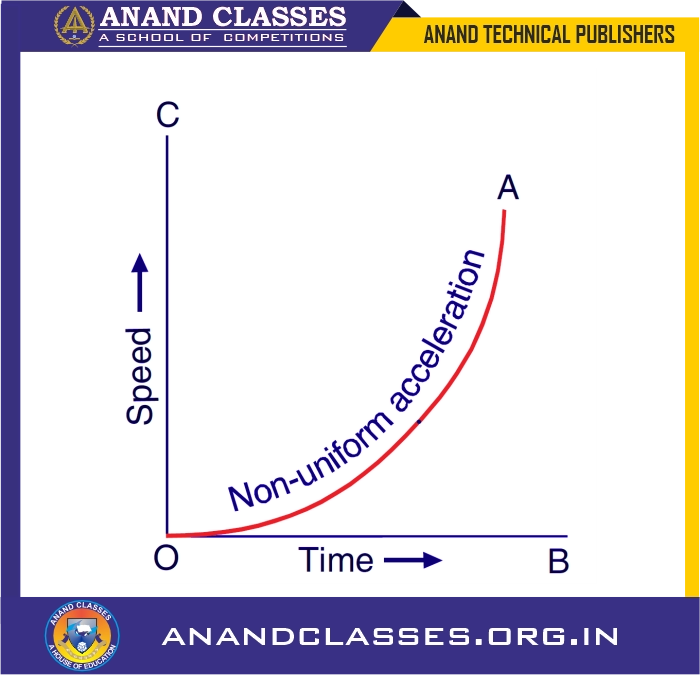
Mathematical Interpretation:
Since acceleration is not constant, we need to integrate the velocity function: $$s = \int v(t)\; dt$$
If the velocity function$\;v(t)$ is known, we can integrate it to find the total distance traveled.
Question-Answer Format for Exams (JEE, NEET, CBSE Class 11)
Q1: What does the slope of a speed-time graph represent?
A: The slope represents acceleration. A positive slope indicates acceleration, while a negative slope indicates deceleration.
Q2: How can distance traveled be determined from a speed-time graph?
A: Distance traveled is given by the area enclosed between the speed-time curve and the time axis.
Q3: What does a horizontal line on a speed-time graph indicate?
A: It indicates uniform speed, meaning there is no acceleration.
MCQs with Answers and Explanations
Q1: The speed-time graph of a body moving with uniform velocity is:
- (A) A straight line parallel to the time axis
- (B) A straight line passing through the origin
- (C) A curve
- (D) A straight line with a negative slope
Answer: (A) A straight line parallel to the time axis
Explanation: A uniform speed means no acceleration, so the graph remains constant over time.
Q2: The acceleration of an object is found using which part of the speed-time graph?
- (A) The area under the graph
- (B) The slope of the graph
- (C) The intercept on the speed axis
- (D) None of these
Answer: (B) The slope of the graph
Explanation: Acceleration is the rate of change of speed with respect to time, which is represented by the slope.
Do You Know?
- A curved speed-time graph means the acceleration is changing.
- The area under a velocity-time graph gives displacement, whereas the area under a speed-time graph gives distance.
- If acceleration is negative, the object is decelerating.
Worksheet
- Draw a speed-time graph for an object moving with constant acceleration.
- How do you determine acceleration from a speed-time graph?
- A car moves with an initial speed of 5 m/s and accelerates uniformly to 20 m/s in 5 seconds. Draw its speed-time graph and find the acceleration.
Test Paper (Marks Distribution)
Total Marks: 20
- Define a speed-time graph and list its types. (4 Marks)
- Explain the concept of acceleration using a speed-time graph. (4 Marks)
- A car starts from rest and attains a velocity of 25 m/s in 5 seconds. Plot a speed-time graph and calculate the distance traveled. (6 Marks)
- Multiple choice questions (2 questions) (6 Marks)
Important Points for Quick Revision
- Speed-time graphs represent motion and acceleration of a body.
- The slope of a speed-time graph gives acceleration.
- The area under the speed-time graph gives distance traveled.
- A straight-line speed-time graph represents uniform acceleration.
- A curved speed-time graph represents non-uniform acceleration.
Best Coaching Center for IIT-JEE, NEET, and Foundations
ANAND CLASSES
Buy complete study material at ANAND CLASSES Store
Proprietor: NIRMAL ANAND Educations
Written by: Neeraj Anand
Published by: Anand Technical Publishers
Contact: +91-9463138669
Email: anandclasses1996@gmail.com
